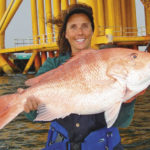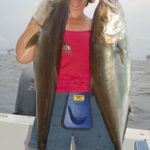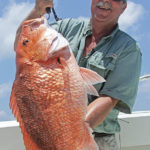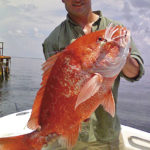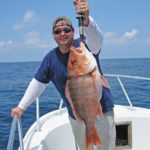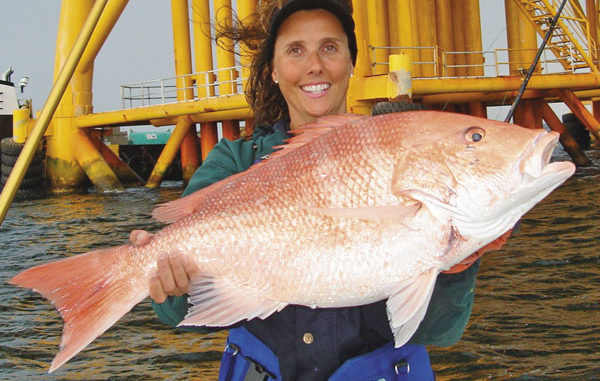
Everyone agrees the waters off the Louisiana coast are teeming with red snapper, but still, anglers will have a painfully short season this year. Why is that?
The red snapper fishery off the Louisiana coast was once a dream world that lured a new captain named Tommy Pellegrin into making a living pulling the succulent fish from around the many rigs and wrecks littering the Gulf. “When I first started 18 years ago, basically there weren’t a whole lot of individual boats running bottom-fishing trips,” Pellegrin said. “The fishery was pretty easy. Red snapper were plentiful.”
He founded Custom Charters out of Cocodrie, and lived the high life of a licensed captain.
But things began changing in the 1990s.
“Slowly (the fishery) diminished,” Pellegrin said. “By about 1998, it really got bad to fish red snapper. You better know where to go to find some keepers, or you would have a hard time catching a limit.”
The problem wasn’t numbers. Instead, it was putting together keepers.
“You’d go through 20, 25 fish to catch your five, and they were just legal,” he said, pointing out that the minimum size limit at that point was only 15 inches. “Something definitely needed to be done because the fishing had gone downhill.”
Twelve years later, Pellegrin said there are still problems.
“I used to post pictures on LouisianaSportsman.com of what I call the 20-pound club,” he said. “Each picture would show … guys on my boat holding 20-pounders.
“That doesn’t happen anymore.”
That’s not to say there aren’t some nice fish caught, but they aren’t those huge specimens.
“The average fish right now is going to be 15 pounds, but there’s not going to be a lot of 20-pounders,” Pellegrin said.
However, the need to take action has spiraled out of control, with ever-tightening restrictions rendering the red snapper fishery almost defunct.
Red snapper season now opens in June, missing the traditional spring run of anglers, and closes no later than Sept. 30. But the reality is that managers can close it earlier, as they did last year by knocking 45 days off the season.
And the daily bag is down to two with a 16-inch minimum.
Sounds logical when the fishery is in trouble, right?
Well, any angler who has wiggled his finger in the waters around any of the rigs off the Louisiana coast can testify that there is no shortage of red snapper. But federal managers refuse to budge, maintaining their science shows snapper are being overfished.
“In the process of all this, over the last three to five years, the stock has built itself up during all that ‘overfishing,’” Pellegrin said. “Everybody out there says, ‘This is like catching catfish under a cleaning table.’
“You can’t put anything in the water without catching something.”
And even the head of the Gulf of Mexico Fisheries Management Council can only shake his head.
“I feel that the reef fish fisheries, especially the red snapper, are very strong,” Bob Shipp said in early March. “There are more red snapper (in the Gulf of Mexico) than anytime in history.”
However, that historical high population has nothing to do with the current regulations, which are aimed at bringing the population to “its current potential.”
Shipp said that potential is a sliding scale, depending on how many rigs or wrecks are in the Gulf at a given time. If one rig is added, for instance, the potential increases and makes it appear there is still much work to do.
“What we’re seeing is the bar being set higher, and we’re going to see it fly higher,” Shipp explained.
The real problem is the “science” officials with the National Marine Fisheries Services insist on using.
“The database is so weak, and the science is so weak,” Shipp said.
That’s because management decisions are being made using the Marine Recreational Fisheries Statistical Survey that estimates how many pounds are being landed.
That this data is a problem is roundly recognized — even by federal officials. In fact, in 2006, the National Research Council declared the MRFSS “fatally flawed.”
That’s because the survey is simply that — a survey of anglers, some of whom never fish for red snapper and other Gulf of Mexico reef fish, upon which statistical models of the supposed health of the fisheries are based.
“The data on which the science is based is flawed,” Shipp said. “It’s not good enough to make dependable, commonsense decisions.”
Jeff Angers of the Center for Coastal Conservation said using this data to start with simply has never made sense.
“MRFSS was never intended to be a management tool,” Angers said. “It’s what we like to call the ‘fisheries management train wreck.’”
MRFSS is being phased out in favor of the Marine Recreational Information Program, but Angers says the new science is still lacking.
“This new plan only corrects some of the statistical flaws in MRFSS,” he explained. “It’s substantially better (than MRFSS), don’t get me wrong, but it’s just MRFSS on steroids.”
The real issue is a complete absence of hard science on the health of the fisheries in the Gulf.
“Thirty-four of the 44 species (in the Gulf) have no science. None, nothing,” Angers said. “They couldn’t tell you how many vermillion snapper were in the Gulf; they could only guess.”
Shipp agreed, saying the alternate being used is based primarily on what fishermen catch.
“MRFSS provides fisheries-dependent data,” he said. “What we need is fisheries-independent data.
“That’s the gold standard, and that’s what everybody would love to have.”
The weakness of fisheries-dependent data is illustrated by looking at the commercial red snapper fishery.
“Commercial fishermen target those 2- to 4-pound fish because that’s what is commercially desired,” Shipp said. “The computer interprets that as, ‘Oh, all the fish are small. All the big fish have been caught.’”
When the computer spits out that interpretation, the current federal response is to panic and tighten regulations.
Shipp said fisheries independent studies would provide a look at the realities of the population separate and apart from what anglers catch. He said it would include such measures as larval surveys and even the use of underwater cameras.
“There are very few (fisheries-independent) studies, and there’s very little data from those few studies we have,” he explained. “There’s lots of science from the fisheries-dependent studies.”
While the Gulf Council receives a lot of slack for mismanagement of the offshore fisheries, Shipp said it’s a little unfair.
“The council for six or seven years has been screaming for more fisheries-independent surveys,” he said.
Refusing to invest in the necessary science is just unacceptable, Reel Screamers Guide Service’s Daryl Carpenter said.
“I think the days of uncertainty, the days of not knowing from scientists, should be over, and they should be held accountable because that’s what affects these seasons,” Carpenter said.
The dearth of solid, fisheries-independent data isn’t just laziness on the part of researchers, Shipp said.
“(Fisheries-independent studies) are very, very expensive, and they take a long time,” he explained. “You need at least four to five years for that (data) to mean anything.
“One year (of data) doesn’t mean anything; you need that longer (study) to detect trends.”
However, there are some moves toward solid science. Shipp said the latest stock assessment was weighted more toward fisheries-independent science, and the results were startling.
“The latest stock assessment reflected a 40-percent upswing (in red snapper),” he said.
The response was an increase in the total allowable catch from 5 million pounds to 6.945 million pounds, with the recreational share of that totaling roughly 3.4 million pounds.
NMFS Regional Administrator Roy Crabtree said in the Montgomery Advertiser on Feb. 21 that this increase is a great sign that management is working.
“The only reason we’re able to allow the TAC to start going up is the projection that overfishing should have ended,” Crabtree told the newspaper. “I think that’s a big accomplishment. It’s something the council has been trying to do for many, many years, and this is the first time we seem to have succeeded.”
However, he warned that anglers exceeding their allotment is a continuing threat to expanded fishing opportunities.
“In theory, the TAC should go up every year,” Crabtree said. “Of course, that is contingent on us not exceeding the quota. We have had some very large overruns the last few years in the recreational sector. We need to correct that problem. If we can stay within the 6.945 million pounds, then the council could come back in and increase the TAC next year, and it could keep increasing each year.
“Ultimately, it will be somewhere in the 13- to 14-million pound range, which is higher than anything we’ve had in a long, long time.”
But don’t expect a longer season or more-generous bag limit anytime soon. Crabtree also told the newspaper the Gulf of Mexico red snapper season will likely run only 51 to 60 days this year.
That means the season would close no later than July 30.
In fact, indications are that federal officials have no intention of increasing the season — with Crabtree ironically blaming successful fishery management.
“The problem is that as the fishing gets better, more people are able to limit out and more people go fishing,” he told the newspaper. “There are all kinds of complicating factors
involved.”
